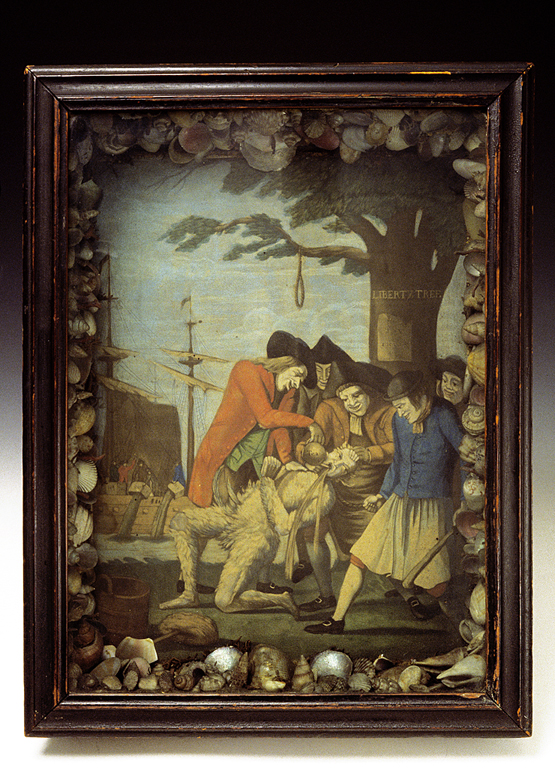| Maker(s): | Dawe, Philip (attributed) | | Culture: | English (1750-1784)
| | Title: | The Bostonians Paying the Excise-Man or Tarring & Feathering; and shellwork shadowbox
| | Date Made: | 1774 and 1774-1775
| | Type: | Print
| | Materials: | gouache, paper, ink, coral, shells, organic material (moss?), glass, wood
| | Place Made: | United Kingdom; England; London and United States; Massachusetts; Boston (probably)
| | Measurements: | framed: 16.3386 x 12.5984 x 3.7402 in.; 41.5 x 32 x 9.5 cm
| | Accession Number: | HD 56.198A
| | Credit Line: | Museum purchase
| | Museum Collection: | Historic Deerfield
|
|

|
Description:
Print (mezzotint) hand-colored in gouache on laid paper, the title of "The Bostonians Paying the Excise-Man or Tarring & Feathering" over "London. Printed for R. Sayer & J. Bennett Map & Printsellers. No. 53 Fleet Street as the Act directs 31 Octr. 1774" has been cut off. From his premises in Fleet Street, Robert Sayer (1725-1794) traded as a print seller and map publisher under his own name from the 1740s until his death, or in partnership with his former apprentice, John Bennett (d.1787) from 1774 to around 1785. In January 1774, John Malcomb, commissioner of customs at Boston, was tarred and feathered, and led to the gallows in a cart while forced to drink large quantities of tea on the route. The print shows five Bostonians pouring tea down the throat of a tarred and feathered man, presumably John Malcomb, and a tar bucket and dabber in the lower left corner. The Liberty Tree with the Stamp Act nailed to it upside down is just behind the group; and men are dumping boxes of tea into the water in the background. For dramatic purposes, the scene alters chronology since the two events were six weeks apart: the Boston Tea Party was Dec. 16, 1773, while Malcomb was tarred on Jan. 29, 1774. By the time this cartoon was issued on Oct. 31, 1774, the two attacks against British authority had probably blended together in the British mind. The excise man was not a popular figure in America, especially after the Stamp Act of 1765. A Germantown, Pennsylvannia, writer described the popular sentiment in a 1765 letter to a classmate: "We have not yet burnt our Stamp Man but I believe there is not much danger of outliving the first essay to execute his office." The print is set in a shellwork shadowbox, probably made in Boston about 1774-1775, with a band of coral, shells, moss, etc. around the edge of the box.
Tags:
caricatures; tea Subjects:
Caricature; Glass Link to share this object record:
https://museums.fivecolleges.edu/detail.php?t=objects&type=ext&id_number=HD+56.198A |